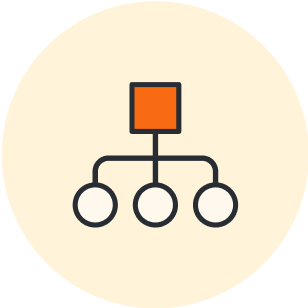It's that time of year again when people make resolutions to be healthier, happier, and more productive. But resolutions aren't just for individuals. If you want your team to be stronger, why not set a New Year's resolution to make process improvements that will keep your business competitive?
Every organization follows processes but few take the time to spell them out. And that's a problem. Because organizations that don't know their processes can't determine if they're successful—or change them if they're not.
Bad processes can lead to inefficiencies, employee burnout, and customer dissatisfaction. But good processes can enhance productivity, engage your team, and create products that ensure customer loyalty and business success. Investing in your company's processes might seem like a big task, but it pays dividends.
Below are some New Year's resolutions you can make to improve your processes and increase efficiency in the new year.
Team resolutions
Processes can only work when teams understand, agree to, and feel inspired by them. Here are some key ways to ensure that your processes are helping your team members to do their work productively and with purpose.
Onboard new team members quickly
Nothing shows the strengths or weaknesses in your work processes quite like bringing in a new member. Onboarding a new team member reveals critical aspects of your organization's processes, from who has what knowledge to how that knowledge is stored and shared.
Most companies adopt ad hoc processes over time and fail to clearly spell out who is in charge of which parts of a process or to document how the organization's processes are communicated. These companies do not keep a centralized bank of information with all the information a new employee needs to do their job. Instead, they rely on existing employees to show new employees the ropes. This lack of standardization can lead to inefficiencies and a lack of clarity for new employees and is especially tricky when some employees work remotely.
Ultimately, it's risky and ineffective to have all the knowledge of a company's processes reside in the heads of certain employees, because when those employees leave, the knowledge leaves with them.
Instead of an ad hoc onboarding process that depends on certain employees communicating informal processes and expectations, create a centralized, documented onboarding process that includes a record of company roles, processes, and expectations that new employees can refer to when starting their new positions. This will allow new team members to be engaged and productive from the start.
Give everyone a chance for their input to be heard
Even the best-laid plans and processes won't work if your team refuses to adopt them. To get buy-in on new processes, it's critical to solicit feedback from the people who will be using them.
You can start by asking for feedback on existing processes. Try starting with a small, daily process that everyone uses and work your way up to the bigger ones. Get feedback from as many people as you can on the process—from team members to managers.
The more people you have responding to the processes, the greater the perspective you'll have on what is and isn't working. Plus, people will feel valued and know that their opinions matter, increasing the likelihood that they'll adopt the new processes going forward.
Create a shared repository of process documentation
One of the best ways to make sure everyone is on the same page is to put everything on the same page—in a centralized documentation repository where everyone can access the plans, steps, and processes they'll use in their work going forward.
Creating a repository helps employees know what team expectations are and who to reach out to for help. It also helps new employees to onboard more quickly and have a clear idea of what they need to do and how. And it helps team members in hybrid work settings, as well, ensuring that everyone has the same information whether they're on-site or not.
Efficiency resolutions
Feel like your team doesn’t need an overhaul of your onboarding or documentation processes? Here are three more New Year’s resolutions around efficiency—something every team could use more of.
Remove bottlenecks
To determine how well your existing processes are working, try creating a process map. A process map visually captures how your processes work, giving you a bird's-eye view of who does what, when, and how.
Once the process map is complete, your team can look it over and evaluate how well things are working, identifying redundancies and bottlenecks as well as what's working. It also helps to determine how long each task currently takes and what could be done to improve efficiency.
After you've created and evaluated your process map, you can set new goals and update workflows to streamline your processes and create greater efficiency.
Increase ROI of a process
Everyone on your team wants a good return on the work they're putting in every day. Even the best processes won't help if you don't know what your goals are. So to get the most out of your processes, make sure your team is clear on what their objectives are and why. Do you want to increase sales? Create a new product? Beat last quarter's revenue?
After you determine your goals, decide how you'll measure success—and then measure again and again. Testing and evaluating your processes gives you real information on whether you're reaching your goals. If you're not, it's time to go back to the drawing board and make process improvements, from reassigning roles to investing in training or new technology.
Cut out busywork with automation
Your team members bring valuable skills to their jobs—don't make them spend their limited resources on tasks that AI could do. Repetitive tasks that don’t require expertise can lead to burnout and decreased employee engagement. Try using technology to do your team's busywork, streamlining processes and allowing your employees to do what they're best at and work they're engaged by.

Want to get a jump-start on documenting your processes? Try out Lucidchart templates!
Explore templatesAbout Lucidchart
Lucidchart, a cloud-based intelligent diagramming application, is a core component of Lucid Software's Visual Collaboration Suite. This intuitive, cloud-based solution empowers teams to collaborate in real-time to build flowcharts, mockups, UML diagrams, customer journey maps, and more. Lucidchart propels teams forward to build the future faster. Lucid is proud to serve top businesses around the world, including customers such as Google, GE, and NBC Universal, and 99% of the Fortune 500. Lucid partners with industry leaders, including Google, Atlassian, and Microsoft. Since its founding, Lucid has received numerous awards for its products, business, and workplace culture. For more information, visit lucidchart.com.
Related articles
Why you should do an end-of-year process audit
In this blog post, we will define a process audit and why it's so important to do one at the end of the year.
How to improve process visualization
In this article we’ll talk about how to improve visualization, even if you are not a visual presentation expert.
How to know if your processes are working
In this article, we'll discuss what to look for when determining how well your processes are working and offer steps to help you design effective processes.
How to spot and fix inefficient processes
In this article we discuss some things that can cause process inefficiency, how to identify them, and how to minimize or fix them.

